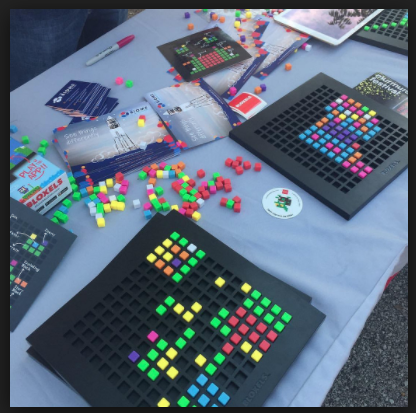
Bloxels

Overview
Bloxels is an innovative video game development platform that allows you to create your own video games. It’s a free app that helps you and your students create games. It’s also a plastic board that fits a collection of plastic pegs of multiple colors.
Students can bring stories to life in a choose your own adventure format. It meets STEAM by integrating the design thinking process and storytelling. The students use analytical thinking and integrate math, science and art while creating and playing the game.
This task card will take several class periods to complete the activities.
The app is free, but the boards are not. For pricing, check the Bloxels website for the educator discount on classroom board sets.
Learning Objectives
Students will:
- Be able to create a game with Bloxels.
- Be able to play and participate in a game of Bloxels.
- Understand the design thinking process.
Vocabulary
Vocabulary Words:
- Bloxel: A free app and board and board game that allows you to create your own video game.
Pre-planning
To prepare for this lesson:
- Purchase the Bloxel board and pieces for $49.
- Download the free Bloxel app on the teacher device and all the student devices. (Go to the App Store on your Device)
- View the Bloxel Intro Video and How-To Guides.
- Practice and play with Bloxels before using with your students.
Accommodations
See the Accommodations Page and Charts on the 21things4students website in the Teacher Resources.
Steps
Directions for this activity:
-
The teacher will Introduce Bloxels to the students.
-
Have them decide what story they are going to tell with Bloxels.
-
Show them one or more of the video tutorials.
-
The students will create the board. Each square is basically a pixel. Characters can be created up to 13x13 pixels.
-
After it is created, the students will use their mobile device or tablet with the Bloxels free app and scan the board.
-
Now the scanned image is ready to be used in the mobile app.
-
Students can build layouts, heroes, and art needed for the video game.
-
Students using the Bloxels Builder app can create game maps, animated heroes and game art, as well as build different elements.
-
After the game has been built, it can be shared and played with others on the Infinity Wall with the unique coordinates.
Note:
- You can turn the sound down or off in settings.
- Remember this is a programming/game creation app - plan time to learn and practice.
- Start by playing an existing game, then try creating a game on the iPad, and finish by creating a game on the board.
- Bloxel games must be created using the app (iPad or Android) but they can be played on a Chromebook.
Assessment Options
Different options for assessing the students:
- Observations
- Check for understanding
- Create a rubric to assess the completed project.
- Imagination and creativity
- Aesthetics
- How well it works
MITECS COMPETENCIES & ISTE STANDARDS
MITECS: Michigan adopted the "ISTE Standards for Students" called MITECS (Michigan Integrated Technology Competencies for Students) in 2018.
Innovative Designer
4a. Students know and use a deliberate design process for generating ideas, testing theories, creating innovative artifacts or solving authentic problems.
4b. Students select and use digital tools to plan and manage a design process that considers design constraints and calculated risks.
4c. Students develop, test and refine prototypes as part of a cyclical design process.
4d. Students exhibit a tolerance for ambiguity, perseverance and the capacity to work with open-ended problems.
Devices and Resources
Device: PC, Chromebook, Mac, iPad
Browser: Chrome, Safari, Firefox, Edge, ALL
App, Extension, or Add-on:
Websites:
Bloxels
CONTENT AREA RESOURCES
ELA
Students mind map/brainstorm ahead of time what the story will be about.
Integrated Arts
Students are completing art projects using Bloxels.
Math
-
The students are using mathematical concepts when they are planning their design.
-
The students are using analytical thinking skills as they create and play the game.
Science
The students are using engineering principles when designing the layout and game.
Credits
This task card was created by Andy Mann, REMC Director, Muskegon Area ISD and Melissa White, 21Things Project Manager. Updated February 2024.


